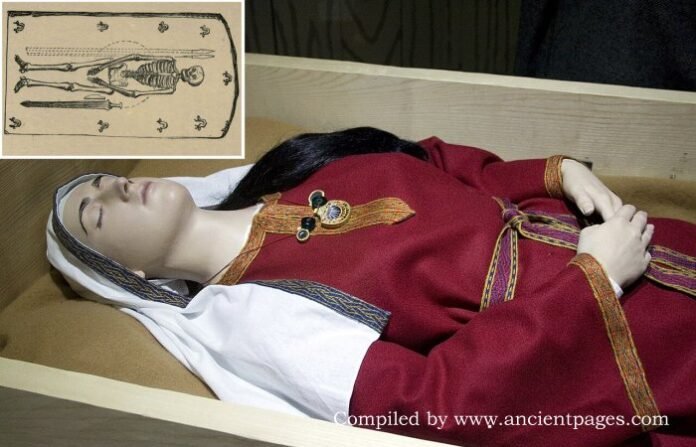Conny Waters – AncientPages.com – A recent study has provided new insights into the tradition and purpose of medieval bed burials, primarily found in Germany, England, and Scandinavia. Researchers have discovered that these rare burial practices are more intricate than previously understood.
Replica of the “Saxon Princess” bed burial at the Street House Anglo-Saxon cemetery. Credit: Prioryman – CC BY-SA 3.0
Many of these burials, dating from the 6th to the early 10th century CE, have not been thoroughly examined or studied collectively, leaving several questions unanswered. However, new knowledge has emerged about the medieval tradition thanks to Dr. Astrid Noterman’s research.
Dr. Noterman published her findings in the European Journal of Archaeology and concluded that bed burials were not a uniform tradition but rather a network of related yet distinct rituals. These practices were significantly influenced by local customs, available materials, and intriguingly, by the origins and lives of the deceased individuals themselves.
Drawing of the Lapwing Hill bed burial. Credit: Jewitt 1870: 209 in Noterman 2025
Dr. Noterman’s research offers valuable insights into the practice of bed burials by analyzing not only the beds themselves but also their locations, associated artifacts, and the identities of those interred.
“This plurality is not limited to regions or time but can also be found within the cemeteries themselves,” Dr. Noterman writes in her study. “It therefore seems necessary to shift the focus of research on bed burials away from a single category and start talking about practices, in the plural.”
In Germany, these burials are typically found in cemeteries that lack distinct features such as orientation. The graves often contained simple wooden bed frames, with both men and women buried alongside modest grave goods like a wooden bowl or ring. Some graves were more elaborate, featuring items such as lyres, candelabras, or even double chairs. Women frequently had weaving tools like spindle whorls, needles, weaving battens, and wooden distaffs included in their graves—symbolically connecting domestic roles to burial rituals.
In England, bed burials usually involved dismantled beds located in cemeteries or occasionally within small ancient burial mounds—a reuse practice common there but not limited to these types of burials. Notably, most English bed burials involve females; however, there is one documented male burial at Lapwing Hill in Derbyshire.
Scandinavian practices stand out for their distinct approach to bed burials; they generally occur as isolated instances rather than being part of larger cemetery complexes.
A reconstruction of the Harpole bed burial. Credit: MOLA / Hugh Gatt
See also: Mystery Of The Anglo-Saxon Harpole Burial Continues – New Clues
The monumental ship burials at Gokstad and Oseberg serve as exemplary instances of Scandinavian bed burials, characterized by their strategic placement near trade waterways to ensure visibility from afar. These burial mounds included both men and women, often accompanied by opulent grave goods that signified status and power.
Dr. Noterman’s research highlights distinct patterns in sub-adult bed burials across regions. In Germany, child burials typically involved those aged three to seven, while in England, they were generally aged thirteen to eighteen. Furthermore, stable isotope analysis revealed that individuals buried at Edix Hill and Trumpington in England had origins in continental Europe. In contrast, two women from the Oseberg ship burial hailed from the Black Sea region.
These findings suggest that bed burials may have been a local tradition within continental Europe, introduced by migrating populations. The study also explores emerging fields, such as the “archaeology of affect,” proposing that bed burials conveyed emotional and symbolic messages to the living.
See also: More Archaeology News
Dr. Noterman emphasizes that beds played a significant role throughout primary life stages—birth, illness, marriage, and death—and their presence in graves might have served not only practical or symbolic purposes but also as a form of communication within Christian or elite Scandinavian societies.
The study was published in the European Journal of Archaeology.
Written by Jan Bartek – AncientPages.com Staff Writer









